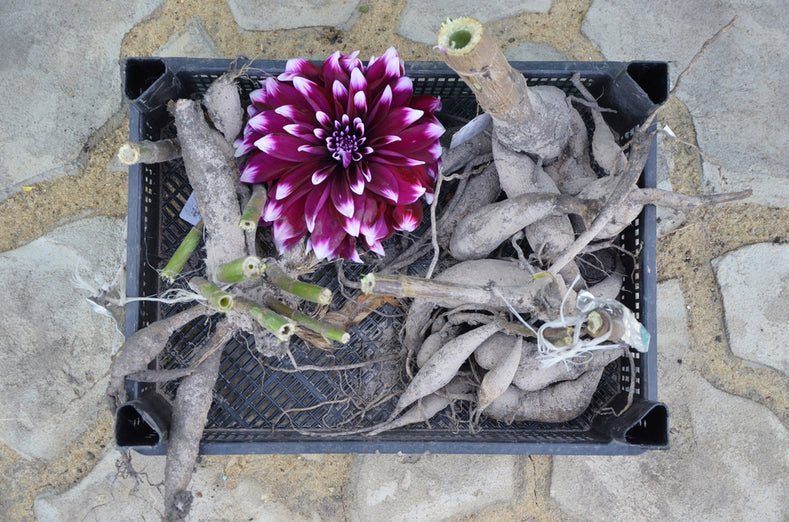Introduction
My name is Aaron Walker, writing for DutchGrown, a family company that offers top quality flower bulbs from Holland. I’ve been a farmer for many years, mostly working in fruit orchards, but I’m also enthusiastic about growing vegetables and flowers in my gardens. Let me share with you some information about an important aspect of one of the most popular perennial flowers, the dahlia.
Why Overwinter Your Dahlia Tubers?
Just by gazing at the vibrant colors and exotic shapes of dahlia blooms you get the impression these flowers are no friends of the cold weather. This is the exact reason that dahlia roots should be dug up every autumn in regions that experience sustained freezing temperatures. This includes most zones in the northern hemisphere (zones 3-7). A few sub-tropical and tropical climates (zones 8-10) are an exception. Dahlias experience a true perennial lifecycle here, where they can be cut back and left in the ground to grow back the following season.
Let’s dig a bit deeper into the process of overwintering your dahlia tubers for the winter so that you can enjoy their beautiful blossoms for years to come.
Timing
First of all, it’s important to dig up the tubers at the right time. The flowers, foliage and stem of dahlias stand no chance against the first heavy frost of the season, and will turn into a brown, slimy pile of mush. It’s not a pretty sight, and sad to watch the growing season pass, but it’s a necessary part of the process. The frost signals to the tubers it’s time to set budding eyes for next year and we want to give them time to develop, so it will be 2 more weeks until the perfect time for digging. But before that frost hits, be sure to label all your favorite and best performing plants, the ones you would like to save and propagate for future seasons.
I live in the northeastern US, so I’m well familiar with this practice. My sister loves her dahlias and has continually propagated tubers for many years now, even taking them with her when she moved to new homes. So, when the time of the season is upon us, I graciously offer to help her dig up the tubers to prepare for winter. The process requires a little work and everybody has their preferred technique, but all said, is quite straightforward and simple.
Cut Back Stalks
After the flowers are killed by the first frost, wait about two weeks. The tubers will get hardy and the budding eyes have time to set. When you’re prepared to dig the tubers, cut the stalk leaving a 3 inch stub.
Dig Up Tubers
Use a shovel or garden fork to slowly work your way around the base of the plant, carefully loosening the soil about a foot away from the stalk. Take your time and work meticulously. The tubers are delicate and you won’t be able to store any that have sustained damage. Gently lift up the loose soil to pop up each part of the tuber cluster. Once they’re all loosened, grab the main stalk and scoop the bunch of tubers, carefully lifting the whole unit from the soil.
Examine Tubers
Take a good look at all of the tubers and save only those that are in the best condition. The clumps of tubers can be stored out of direct sun and freezing temperatures to air dry for a few days. After this short curing period, lightly dust off any loose soil and trim back the root hairs.
Prepare For Storage
If you have enough space, store the whole cluster of tubers. When left intact, they are better insulated and less prone to dehydration. And in the spring green, new growth will reveal which tubers are viable for planting, saving you some work ahead of time.
Tubers can also be separated before overwintering to save space. First, you’ll want to identify the eyes. They can be found where the main stalk connects to the tuber. Much like a potato, these little nubs are where next year’s growth will sprout from. Using a clean knife cut free the individual tubers, making sure each has an eye and small piece of the stem. The wounds should be allowed to dry and form a callus before being set into storage.
Overwinter Dahlia Tubers
When tubers are dried sufficiently and trimmed up, they’re ready to store. The methods of storage can vary based on your space, and who you ask!
The ideal storage environment is dark, moderately humid and stays between 40-50 degrees F. Any place that remains cool, dim and above freezing temperatures should do the job. Basements, porches and sheds are typically good options.
If the location is on the humid side, paper bags or cardboard boxes make nice containers, as they will absorb some of the excess moisture. Otherwise, if the storage space is quite dry, it’s safe to use large trash bags, plastic buckets or totes. Just be sure they don’t collect condensation, which is a sign of too much moisture.
The tubers can be packed alone or in some form of medium as insulation. Some growers prefer to fill their storage containers with peat moss, wood mulch, vermiculite, newspaper, or potting mix. The only correct method will be the one that works best for you!
It will likely take a season or two of trial and error. If you are to take any bit of advice from this article, heed these few hard rules of thumb: Keep tubers dark, cool but not freezing and let them breathe.
Check Tubers Regularly
Tubers should be inspected periodically throughout the winter.
- If any are soft and shriveled, they’re probably dehydrated. They can be lightly misted with water if humidity levels get too low.
- Increase air circulation if there is condensation accumulating in the containers.
- Maintain temperatures between 40 and 50 degrees F.
- Immediately remove and discard damaged or rotting tubers that might infect the rest of the bunch.
And that’s it!
Now it’s time to wait for warm weather and dream about your spring gardening aspirations.
Looking Forward To Spring
Healthy dahlia tubers will be plump, firm and could even be showing some signs of life by springtime. They won’t be completely ready for planting until all danger of frost has passed, but it won’t be long before gorgeous dahlia blooms will once again be gracing your summer flower beds.
Aaron Walker - Guest Writer DutchGrown





